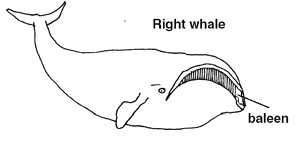
| Glasgow Digital Library | Voyage of the Scotia | BRUCE | PEOPLE | SHIP | ANTARCTIC | INDEX |
|---|

The four ships of the 1892-93 Dundee whaling expedition were mainly interested in right whales, for which plankton is the main diet. A large screen of very flexible whalebone attached to the upper jaw is used to filter their food. This material is called baleen and the right whale is Balaena mysticetus. (The ship which Bruce sailed to the Antarctic was called Balaena.) At the end of the 19th century baleen was used mainly to stiffen women's corsets and dresses.
There were, however, large numbers of whales in the Antarctic and the first man to realise the potential of the southern oceans was Captain Carl Larsen. Larsen was captain of Antarctic on the Swedish Antarctic expedition, which was trapped and sunk in the Weddell Sea. After rescue by the Argentine ship Uruguay he persuaded the Argentinian authorities to finance a whaling station on South Georgia.
Larsen had been on two whaling expeditions to the Antarctic - in 1892 on Jason (which met up with the Dundee whaling expedition) and in 1894. In 1904 he formed the Compania Argentina de Pesca and a whaling base was established at Grytviken on South Georgia under licence with the British authorities.
| Glasgow Digital Library | Voyage of the Scotia | BRUCE | PEOPLE | SHIP | ANTARCTIC | INDEX |
|---|